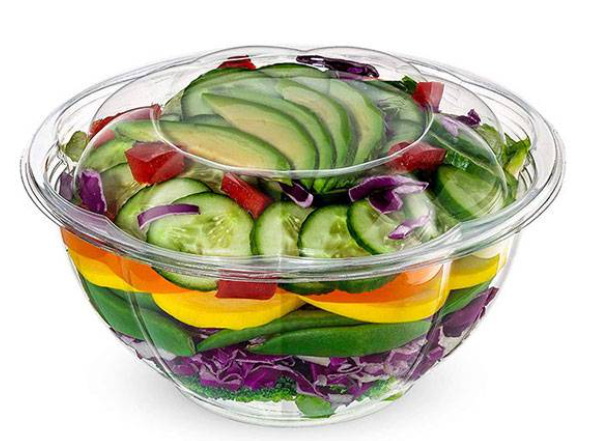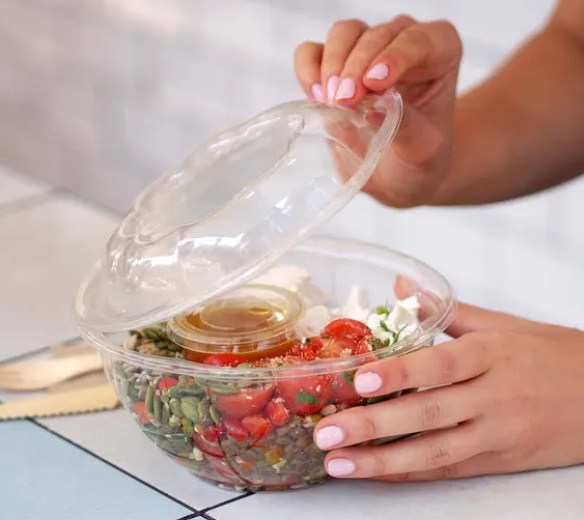
Content Menu
● Introduction to PLA
>> Benefits of PLA
● Disposable PLA Salad Bowls: A Sustainable Choice
>> Features of Disposable PLA Salad Bowls
>> Environmental Impact of PLA Bowls
● Environmental Impact of Traditional Plastic Bowls
>> Comparison with PLA Bowls
● Health Benefits of PLA Bowls
>> Supporting Sustainable Practices
● Challenges and Future Directions
● Market Trends and Growth
>> Factors Driving Market Growth
● Consumer Preferences and Sustainability
>> Impact on the Food Service Industry
● Conclusion
● FAQs
>> 1. What is PLA, and how is it made?
>> 2. Are PLA bowls suitable for hot foods?
>> 3. How long does it take for PLA bowls to compost?
>> 4. What are the environmental benefits of using PLA bowls?
>> 5. Can PLA bowls be microwaved?
● Citations:
In recent years, the world has witnessed a significant shift towards sustainability, with consumers and businesses alike seeking eco-friendly alternatives to traditional plastics. One such innovation is the disposable PLA salad bowl, made from polylactic acid (PLA), a bioplastic derived from renewable plant resources like corn starch and sugarcane. This article explores how these bowls contribute to a greener future and why they are becoming a staple in the food service industry.

Introduction to PLA
PLA is a biodegradable and compostable material, offering a sustainable alternative to petroleum-based plastics. It is lightweight, flexible, and suitable for cold food applications, making it ideal for salads, desserts, and other chilled dishes.
Benefits of PLA
- Renewable Resource: PLA is made from annually renewable resources, reducing dependence on fossil fuels.
- Biodegradable: It can be composted in industrial facilities, significantly reducing landfill waste.
- Lightweight and Flexible: PLA products are easy to handle and transport.
Disposable PLA Salad Bowls: A Sustainable Choice
Disposable PLA salad bowls are designed to be compostable, breaking down in commercial composting facilities within a few months. This feature not only reduces plastic waste but also creates nutrient-rich compost for agricultural use.
Features of Disposable PLA Salad Bowls
- Compostable: Certified by organizations like the Compost Manufacturing Alliance (CMA) and Biodegradable Products Institute (BPI).
- Light and Strong: Comparable to traditional plastic in durability but made from plant-based materials.
- Stackable: Designed for efficient storage and transportation.
- Temperature Resistance: Suitable for temperatures up to 120°F (49°C).
Environmental Impact of PLA Bowls
PLA bowls have a lower carbon footprint compared to traditional plastic bowls. The production process involves fewer emissions and less energy consumption, making them a responsible choice for eco-conscious consumers[1][2].

Environmental Impact of Traditional Plastic Bowls
Traditional plastic bowls are made from non-renewable resources and contribute significantly to plastic pollution. They take hundreds of years to decompose, often ending up in landfills or oceans, harming marine life and ecosystems[1][2].
Comparison with PLA Bowls
| Feature | Traditional Plastic Bowls | Disposable PLA Salad Bowls |
| Material | Petroleum-based | Plant-based (PLA) |
| Biodegradability | Non-biodegradable | Compostable in industrial facilities |
| Environmental Impact | High pollution risk | Low environmental impact |
| Durability | Durable but non-renewable | Durable and renewable |
Health Benefits of PLA Bowls
Unlike traditional plastic bowls, which may leach chemicals into food, especially when heated, disposable PLA salad bowls are free from harmful substances. This ensures that your meals remain safe and uncontaminated[1].
Supporting Sustainable Practices
By choosing disposable PLA salad bowls, consumers support sustainable business practices and encourage further innovation in eco-friendly packaging solutions. This support fosters a culture of sustainability, driving demand for more environmentally friendly products[1][4].
Challenges and Future Directions
While disposable PLA salad bowls offer numerous benefits, their adoption faces challenges such as educating consumers about proper disposal methods and establishing efficient composting infrastructure. Technological advancements and policy changes are crucial for overcoming these challenges[5].
Market Trends and Growth
The disposable bowls market is experiencing significant growth, driven by consumer demand for convenience and sustainability. The market is projected to reach USD 24.5 billion by 2033, with a focus on eco-friendly materials like PLA[3][6].
Factors Driving Market Growth
- Convenience and Hygiene: Disposable bowls offer a convenient and hygienic solution for food service providers.
- Sustainability: Consumers increasingly prefer eco-friendly alternatives to traditional plastics.
- Innovation: Advances in material science have led to the development of compostable and biodegradable bowls.
Consumer Preferences and Sustainability
As consumers become more environmentally conscious, their preferences are shifting towards sustainable products. Businesses that offer eco-friendly options like disposable PLA salad bowls are seen as responsible and innovative, attracting a loyal customer base[3][4].
Impact on the Food Service Industry
The food service industry is heavily reliant on disposable tableware. By adopting disposable PLA salad bowls, restaurants and food delivery services can reduce their environmental footprint while maintaining efficiency and customer satisfaction.
Conclusion
In conclusion, disposable PLA salad bowls are a significant step towards reducing plastic waste and promoting sustainability. By choosing these eco-friendly alternatives, consumers can contribute to a cleaner environment, healthier meals, and support innovative businesses. As the world continues to embrace sustainable practices, the demand for compostable packaging is expected to grow, paving the way for a greener future.

FAQs
1. What is PLA, and how is it made?
PLA (Polylactic Acid) is a bioplastic derived from renewable resources such as corn starch and sugarcane. It is produced through a fermentation process where microorganisms convert the plant-based materials into lactic acid, which is then polymerized into PLA.
2. Are PLA bowls suitable for hot foods?
PLA bowls are best suited for cold or chilled foods. They can handle temperatures up to 120°F (49°C) but are not recommended for hot foods as they may deform or melt.
3. How long does it take for PLA bowls to compost?
PLA bowls can compost in 2-4 months in a commercial composting facility. However, they may not break down as quickly in home composting setups.
4. What are the environmental benefits of using PLA bowls?
Using PLA bowls reduces greenhouse gas emissions, conserves non-renewable resources, and diverts waste from landfills. They also create nutrient-rich compost that can enrich soils.
5. Can PLA bowls be microwaved?
No, PLA bowls should not be microwaved. They are not designed to withstand high heat and may melt or deform when exposed to microwave radiation.
Citations:
[1] https://www.freshtableware.in/post/why-are-biodegradable-salad-bowls-better-than-plastic-bowls
[2] https://pmc.ncbi.nlm.nih.gov/articles/PMC8199738/
[3] https://www.verifiedmarketreports.com/product/disposable-bowls-market/
[4] https://ponypackaging.com/blogs/news/what-makes-compostable-disposable-salad-bowls-the-ideal-choice
[5] https://www.plasticsengineering.org/2024/02/pla-sustainable-003757/
[6] https://datahorizzonresearch.com/disposable-bowls-market-9367
[7] https://www.globenewswire.com/news-release/2025/03/12/3041529/0/en/Disposable-Food-Containers-Market-Set-for-Steady-Growth-Projected-to-Reach-USD-29-774-8-Million-by-2035-with-a-CAGR-of-4-4-Future-Market-Insights-Inc.html
[8] https://www.biofutura.com/en/pla-disposables
[9] https://www.filamentive.com/how-sustainable-is-pla/
[10] https://www.futuremarketinsights.com/reports/disposable-plates-market
[11] https://www.sweetflavorfl.com/blog/everything-you-need-to-know-about-disposable-salad-bowls-n14
[12] https://www.biopak.com/au/resources/what-is-pla
[13] https://www.gminsights.com/industry-analysis/disposable-tableware-market
[14] https://www.mdpi.com/2071-1050/17/4/1434
[15] https://www.reddit.com/r/3Dprinting/comments/1cepxie/is_pla_really_eco_friendly/
[16] https://www.mordorintelligence.com/industry-reports/food-trays-and-bowls-market
[17] https://foogogreen.com/blog/benefits-of-ecofriendly-disposable-plates/
[18] https://filamatrix.com/the-eco-friendly-traits-of-pla-3d-printing-filament/
[19] https://www.swiftpak.co.uk/insights/why-is-pla-not-sustainable
[20] https://www.mingkay.com/news/57.html

















